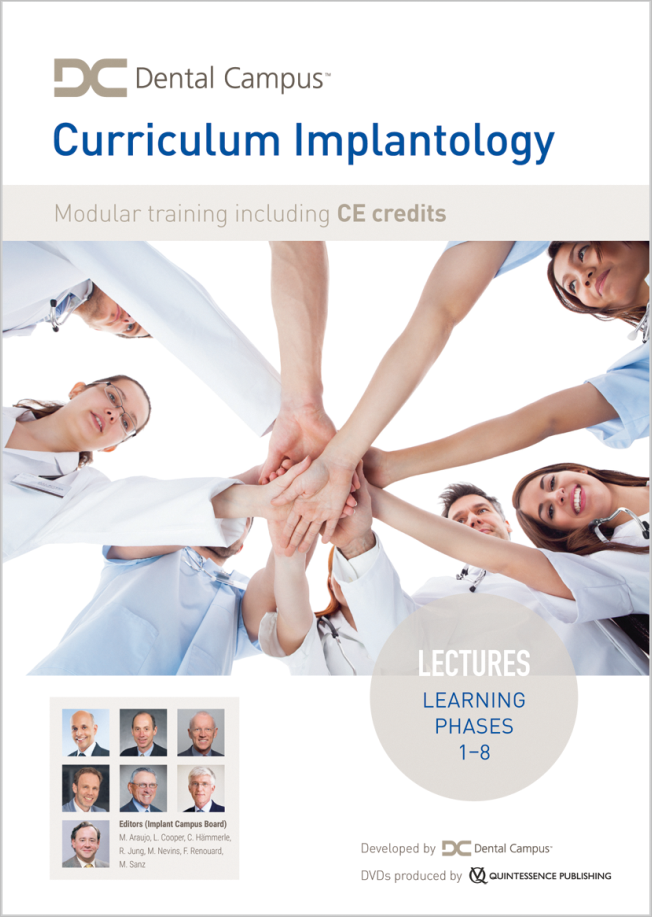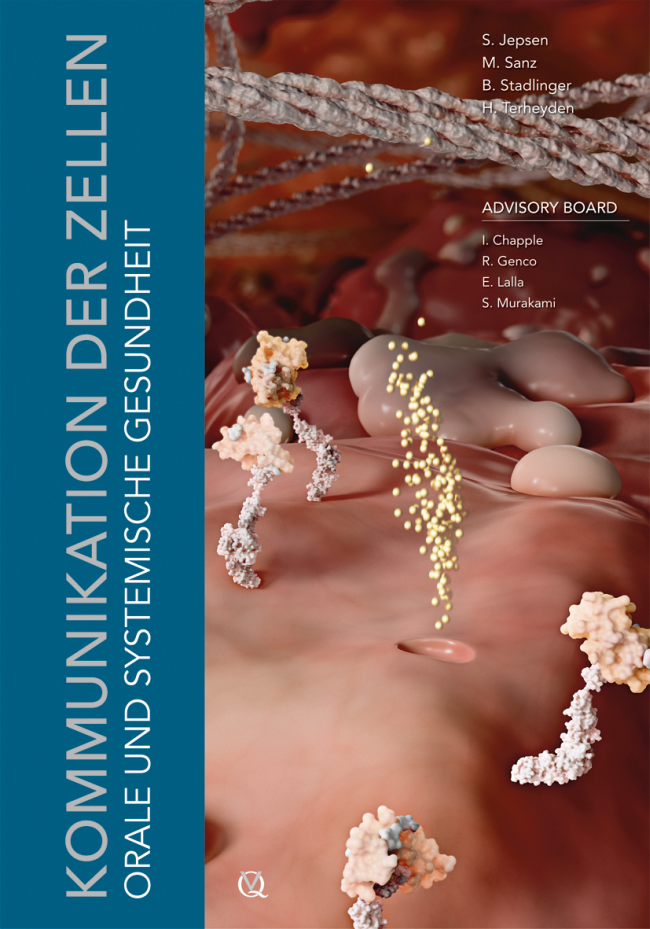International Journal of Periodontics & Restorative Dentistry, Pre-Print
DOI: 10.11607/prd.76535. Mai 2025,Seiten: 1-21, Sprache: EnglischGonzalez-Martin, Oscar / Sanz, MarianoSurgical crown lengthening (SCL) is a predictable method of increasing the availability of supragingival tooth structure for biological, aesthetic and/or restorative reasons. However, the literature demonstrates a lack of precision when performing this common procedure due to a number of factors. Among those factors, the use of standardised measurements and reference points as well as the limitations inherent to the classical surgical protocol will be presented. This review discusses the importance of individualising supracrestal soft tissue dimensions during SCL interventions and the use of appropriate diagnostic tools while taking into account the phenotypic characteristics of the patient in both functional and esthetic crown lengthening.
International Journal of Computerized Dentistry, Pre-Print
ScienceDOI: 10.3290/j.ijcd.b632920925. Juni 2025,Seiten: 1-34, Sprache: EnglischPedrinaci, Ignacio / Nasseri, Anita / Calatrava, Javier / Couso-Queiruga, Emilio / Giannobile, William V. / Gallucci, German O. / Sanz, MarianoAims: The primary aim of this in vitro study was to compare methods for generating 3D-printed replicas through virtual segmentation, utilizing artificial intelligence (AI) or manual processes, by assessing accuracy in terms of volumetric and linear discrepancies. The secondary aims were the assessment of time efficiency with both segmentation methods, and the effect of post-processing on 3D-printed replicas. Methods: Thirty teeth were scanned through Cone Beam Computed Tomography (CBCT), capturing the region of interest from human subjects. DICOM files underwent virtual segmentation through both AI and manual methods. Replicas were fabricated with a stereolithography 3D printer. After surface scanning of pre-processed replicas and extracted teeth, STL files were superimposed to compare linear and volumetric differences using the extracted teeth as the reference. Post-processed replicas were scanned to assess the effect of post-processing on linear and volumetric changes. Results: AI-driven segmentation resulted in statistically significant mean linear and volumetric differences of -0.709mm (SD 0.491, P< 0.001) and -4.70%, respectively. Manual segmentation showed no statistically significant differences in mean linear, -0.463mm (SD 0.335, P<0.001) and volumetric (-1.20%) measures. Comparing manual and AI-driven segmentations, AI-driven segmentation displayed mean linear and volumetric differences of -0.329mm (SD 0.566, p=0.003) and -2.23%, respectively. Additionally, AI segmentation reduced the mean time by 21.8 minutes. When comparing post-processed to pre-processed replicas, there was a volumetric reduction of -4.53% and a mean linear difference of -0.151mm (SD 0.564, p=0.042). Conclusion: Both segmentation methods achieved acceptable accuracy, with manual segmentation slightly more accurate but AI-driven segmentation more time-efficient. Continuous improvement in AI offers the potential for increased accuracy, efficiency, and broader application in the future.
Schlagwörter: 3d printing, artificial intelligence, autotransplant, computeraided- manufacturing, digital dentistry, Stereolithography
International Journal of Periodontics & Restorative Dentistry, Pre-Print
DOI: 10.11607/prd.7286, PubMed-ID: 392703116. Sept. 2024,Seiten: 1-24, Sprache: EnglischPalombo, David / Mascetti, Tommaso / Zucchelli, Giovanni / Sanz, MarianoThe management of severe mucogingival deformities surrounding malpositioned implants represents a complex issue with a high risk of aesthetic failure. The present case report describes a mucogingival and restorative approach for the treatment of severe localized peri-implant tissue deficiencies with interproximal bone loss combined with an interproximal gingival recession on the adjacent natural tooth. This consists of maintaining a non-restorable malpositioned implant, submerging it through one or multiple vertical soft tissue augmentations, according to the defect severity, and delivering a tooth supported bridge involving the adjacent natural teeth. The step-by-step surgical technique adopted for implant submergence and vertical soft tissue grafting, as well as the subsequent surgical and prosthetic interventions, are described, presenting results at 5 years from implant submergence and 3 years from prosthetic finalization.
Schlagwörter: Implants, Periodontal Surgery, Prosthetic Dentistry, Gingival Recession, Mucogingival Surgery, Dental Implant, Case Report
International Journal of Periodontics & Restorative Dentistry, 5/2024
DOI: 10.11607/prd.2024.5.e, PubMed-ID: 39283759Seiten: 496-497, Sprache: EnglischZabalegui, Ion / Sanz, MarianoEditorial International Journal of Periodontics & Restorative Dentistry, 5/2023
DOI: 10.11607/prd.2023.5.e, PubMed-ID: 37733467Seiten: 537-539, Sprache: EnglischTonetti, Maurizio S. / Heitz-Mayfield, Lisa / Papapanou, Panos N. / Sanz, MarianoEditorialConsensus on a valid and comprehensive set of outcomes to capture the full benefits and harms of implant dentistry interventions is key for progressing toward better clinical guidelines and policy. In this field, research remains fragmented and uses too many different outcomes. Studies are unable to cover the full breadth necessary to properly evaluate benefits, harms, and costs. Best-practice examples inspired the Implant Dentistry Core Outcome Set and Measurements (ID-COSM) initiative that identified four core outcome domain areas (pathophysiology, implant/prosthesis lifespan, life impact, and access to care), five essential outcomes mandatory for all trials, and six outcomes mandatory in specific circumstances. This innovative multistep approach combined input from scientific evidence, patients from multiple countries, methodologists, and industry representatives. The ID-COSM consensus aspires to contribute to better adoption of relevant and valid outcomes in trials and enable their results to be combined in high-quality meta-analyses to support better-informed care and policy.
Quintessence International, 1/2022
DOI: 10.3290/j.qi.b1763645, PubMed-ID: 34269040Seiten: 24-34, Sprache: EnglischCalzavara, Dino / Morante, Segio / Sanz, Javier / Noguerol, Fernando / Gonzalez, Jerian / Romandini, Mario / Sanz, MarianoObjectives: The aim of this retrospective case series was to report the performance up to 5 years of an innovative surgical design (the apically incised coronally advanced surgical technique [AICAST]) for the regenerative treatment of one- or two-walled intrabony periodontal lesions.
Method and materials: After completion of standard step I to II periodontal therapy, nine isolated periodontal defects were treated through AICAST. The following clinical outcome measurements were collected before the surgical intervention and at the last available follow-up: probing pocket depth (PPD), recession depth (REC), and clinical attachment level (CAL). Periapical radiographs of the treated teeth were also taken at baseline and at the last available follow-up (18 months or 5 years postoperatively).
Results: A mean (± standard deviation) PPD reduction of 6.05 ± 1.76 mm (P < .01), REC reduction of 1.15 ± 1.97 mm (P = .119), and CAL gain of 7.20 ± 2.13 mm (P < .01) were attained when comparing preoperative results with the last follow-up visit. CAL gain of 6 mm or more was reached in eight out of nine treated cases (88.9%), with a residual PPD of 2 to 3 mm in all the cases. Complete radiographic fill of the intrabony component was present in all the defects, while detectable suprabony radiographic filling was identified in two cases.
Conclusion: AICAST represents an innovative surgical design for the treatment of deep intrabony defects and the eventual reduction of the associated gingival recessions. Preliminary results show good performance in terms of clinical attachment gains and maintenance of the marginal tissues.
Schlagwörter: coronally advanced flap, enamel matrix derivatives (EMD), papilla preservation flap, periodontal regeneration, periodontitis
Oral Health and Preventive Dentistry, 1/2021
Open Access Online OnlyPeriodontologyDOI: 10.3290/j.ohpd.b875525, PubMed-ID: 3349137426. Jan. 2021,Seiten: 15-24, Sprache: EnglischTomšič, Katja / Rodič, Katarina / Sotošek, Anja / Videmšek, Petja / Seme, Katja / Herrera, David / Sanz, Mariano / Gašperšič, RokPurpose: To investigate the subgingival microbiological profiles of patients with periodontitis, to determine their stage and grade scores and to evaluate the differences in the microbiota among different stages and grades.
Materials and Methods: Sixty-seven (n = 67) periodontitis patients were selected. Periodontitis staging and grading, following the 2018 classification system, were defined. Following a clinical examination, subgingival samples were taken from the deepest periodontal pocket of each quadrant for cultivation, identification and quantification. The prevalence, proportion and counts of nine selected periodontal pathogens were determined, and differences between periodontitis stages III and IV and grades B and C were assessed.
Results: All nine cultivable periodontal bacteria were detected, of which the most prevalent was P. intermedia (91.0%) and the least prevalent were E. corrodens (9.0%) and C. ochracea (9.0%). The frequency of detection of the two main target pathogens, A. actinomycetemcomitans and P. gingivalis, was 41.8% and 76.1%, respectively. The prevalence (grade B: 80.6%, grade C: 55.6%, p = 0.035) and total counts (grade B: 19.8 colony forming units – CFU/ml-4 (1.9–52.8); grade C: 4.0 CFU/ml-4 (0.0–26.4); p = 0.022) of F. nucleatum were statistically significantly higher in grade B than in grade C periodontitis patients, whereas the counts of P. gingivalis and A. actinomycetemcomitans were similar between grades and stages.
Conclusion: Our study suggests that relevant differences between the various grades of periodontitis exist only in the numbers of F. nucleatum. Prevalence and quantities of other cultivable species between different stages and grades of periodontitis seem to be similar.
Schlagwörter: periodontitis, stage, grade, Porphyromonas gingivalis, Aggregatibacter actinomycetemcomitans, Fusobacterium nucleatum
Oral Health and Preventive Dentistry, 1/2020
Open Access Online OnlyPeriodontologyDOI: 10.3290/j.ohpd.a44444, PubMed-ID: 326184594. Juli 2020,Seiten: 363-371, Sprache: EnglischGraziani, Filippo / Minenna, Luigi / Karapets, Dimitra / Herrera, David / Nisi, Marco / Gennai, Stefano / Gabriele, Mario / Discepoli, Nicola / Petrini, Morena / Marhl, Urška / Perić, Marina / Adriaen, Laurence / Alonso, Bettina / Bouchard, Philippe / Cardaropoli, Daniele / Cavalcanti, Raffaele / Chackartchi, Tali / Franch-Chillida, Fernando / Gianserra, Rodolfo / Guerrero, Adrian / Landi, Luca / Masiero, Silvia / Mensi, Magda / Moratti, Paolo / Oreglia, Francesco / Rupe, Antonio / Sanchez, Ignazio / Sforza, Nicola / Capri, Diego / Zabalegui, Ion / Sanz, Mariano / Tonetti, Maurizio / Tomasi, CristianoPurpose: No information is available on the perception of the quality of care in patients treated for periodontitis. The purpose of this article was to assess how periodontitis-affected patients perceive the quality of periodontal treatment (PT) and to measure the factors which may influence it.
Materials and Methods: 306 subjects who completed PT were invited to participate. Questionnaires and visual analogic scales (VAS) evaluating perception of quality of care, symptoms, and oral health related quality of life (OHRQoL) were handed out. Oral and periodontal indicators were collected before and after treatment. The impact of different factors on perception of quality was assessed with a regression model.
Results: Quality evaluation was high yet unrelated for both patients and clinicians (p = 0.983). Quality was negatively influenced by the number of residual oral infections (p 0.001), patient's age (p = 0.07) and presence of residual pain at completion of PT (p = 0.02). Professionalism, kindness of the staff and communication skills were the characteristics mostly appreciated. The OHRQoL was influenced by the number of residual teeth (p 0.001), increasing age of patients (p = 0.08), number of residual infections (p 0.01) and pain (p = 0.04).
Conclusions: Patients' quality perception appeared to be influenced by clinical and emotional aspects. Oral care providers should be aware of the impact of non-clinical factors in patients' appreciation of quality of treatment.
Schlagwörter: oral health related quality of life, periodontitis, quality of care
International Journal of Periodontics & Restorative Dentistry, 4/2019
DOI: 10.11607/prd.3329, PubMed-ID: 29897350Seiten: 517-524, Sprache: EnglischCha, Jae-Kook / Sanz, Mariano / Jung, Ui-WonThis report presents a histologic assessment of guided bone regeneration for dehiscence defects treated with bovine bone mineral or a combination of autogenous and synthetic bone. The samples were obtained from an autopsy specimen donated by a patient, which is a rare opportunity to evaluate longterm results of guided bone regeneration and osseointegration. The values for bone-to-implant contact were similar in both sites. The augmentation with bovine bone mineral demonstrated bone reconstruction after 1 year, whereas the augmentation with autogenous and synthetic bone failed to maintain the augmented volume, eventually leading to mucosal recession after 5.5 years.
International Journal of Periodontics & Restorative Dentistry, 5/2018
DOI: 10.11607/prd.3566, PubMed-ID: 30113607Seiten: 683-690, Sprache: EnglischNúñez, Javier / Sanz-Esporrin, Javier / Caffesse, Raul / Sanz, MarianoRoot coverage in the anterior mandible is challenging due to a thin gingiva, shallow vestibule, and/or high frenulum. This case series reports on the flattening of the root surface to create a new emergence profile conceived with a two-step surgical approach aimed at providing more space for the graft, increasing the thickness of the gingival margin, and getting extra soft tissue in the open area of the recession. A total of 10 patients with recessions affecting the mandibular incisors were treated to evaluate this two-step approach, which included odontoplasty of the root followed by a connective tissue graft. At 1 year, the mean coverage was 100% in Class II recessions, and 80.5% in Class III. The mean keratinized tissue increase was 5.80 ± 1.75 mm. This surgical approach could be proposed as an alternative when treating mandibular anterior teeth with root prominence or with a buccally tilted position.







